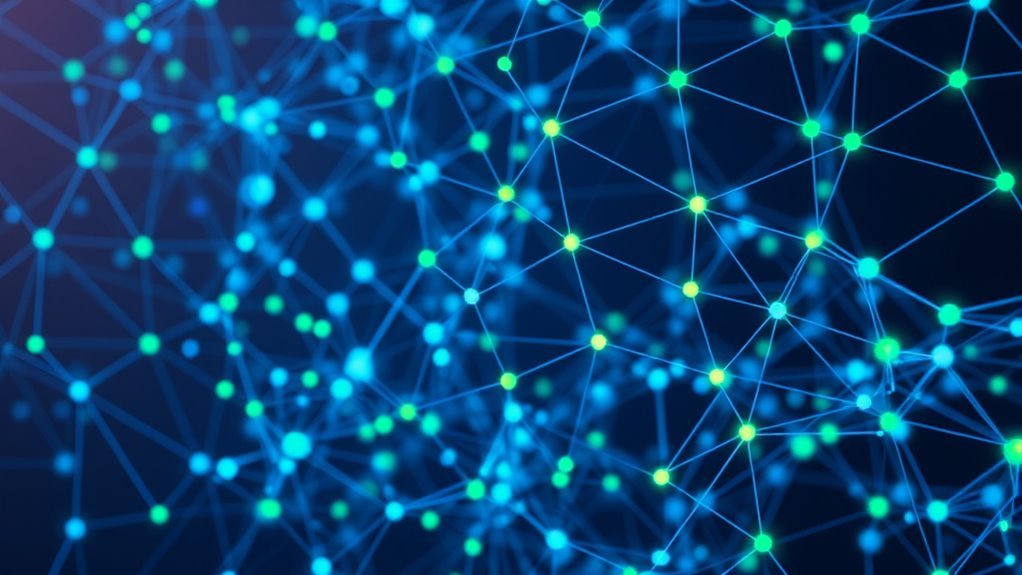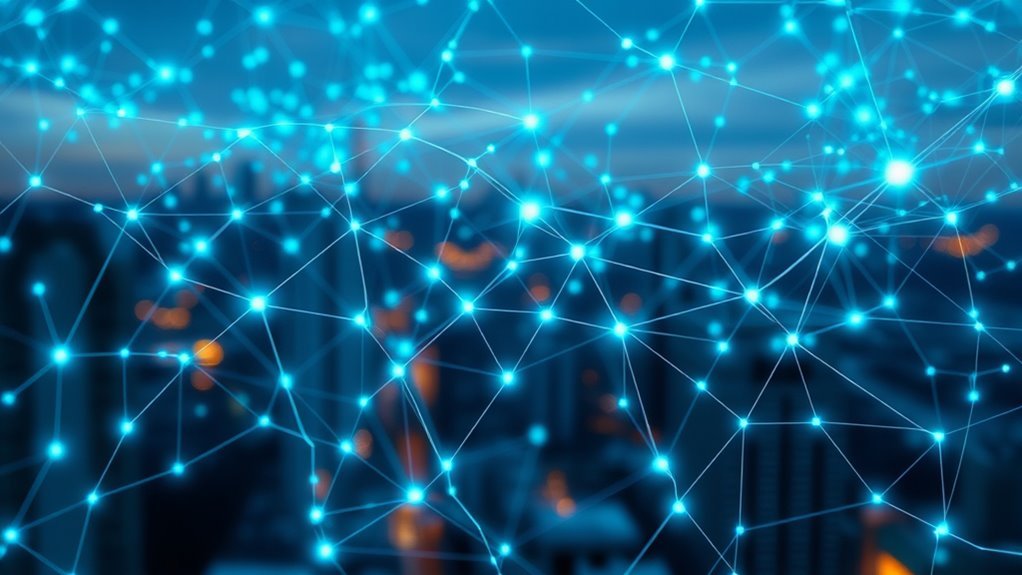You’ll find Graph Neural Networks (GNNs) powerful for social network analysis by modeling nodes and edges to capture complex relationships. Their architecture, including convolutional layers and attention mechanisms, enables nuanced feature extraction and topology sensitivity. Techniques like Node2vec embeddings enhance representation quality. Popular models such as GCNs and GATs excel in tasks like community detection and influence prediction. Despite scalability and interpretability challenges, ongoing advancements aim to improve performance and applicability in evolving networks, which you can explore further.
Understanding Graph Neural Networks

Although graph neural networks (GNNs) may seem complex at first, understanding their core principles is essential for analyzing social networks effectively. You’ll need to grasp how graph representations encode nodes and edges, capturing relationships and structural dependencies within social data. GNNs leverage neural architectures designed specifically to process these graph-structured inputs, enabling you to infer patterns that traditional models miss. By iteratively aggregating and transforming information across connected nodes, these architectures facilitate learning representations sensitive to both local and global network topology. Mastering this approach gives you the freedom to explore social dynamics with greater accuracy and insight. Ultimately, appreciating the rationale behind graph representations and tailored neural architectures empowers you to harness GNNs’ full analytical potential in social network contexts.
Key Components of GNN Architecture

When you explore the architecture of graph neural networks, you’ll find several essential components that work together to process graph-structured data efficiently. These components enable the model to capture complex relationships and patterns within social networks. Key elements include:
- Node aggregation and message passing for collecting and exchanging information across nodes
- Edge normalization to balance influence from different neighbors
- Graph convolution layers that perform localized feature extraction
- Attention mechanisms to weigh node importance dynamically, especially in dynamic graphs
- Pooling strategies and hierarchical structures for reducing graph complexity while preserving essential features
Additionally, feature propagation facilitates information dissemination through layers, while layer normalization stabilizes training. Together, these components provide the flexibility and precision needed for analyzing social networks effectively.
Representing Social Networks as Graphs

To model social networks effectively, you’ll need to define nodes as individuals or entities and edges as their interactions or relationships. You’ll encounter various types of social graphs, such as directed, undirected, weighted, or multiplex, each capturing different connection dynamics. Choosing the right graph data structure is essential for efficient computation and accurate representation of social information.
Nodes and Edges Defined
In graph theory, nodes and edges are the fundamental components that structure social networks. When you analyze social graphs, you’ll find nodes represent individuals or entities, while edges symbolize the relationships or interactions between them. Understanding node importance helps you identify influential users or hubs, while edge weight quantifies the strength or frequency of connections, offering deeper insights.
Consider these key aspects:
- Nodes correspond to social actors or data points.
- Edges define relationships, directional or bidirectional.
- Node importance measures influence or centrality.
- Edge weight captures interaction intensity or trust.
- Both combine to reveal network topology and dynamics.
Grasping these definitions equips you to model and analyze social systems effectively using graph neural networks.
Types of Social Graphs
Social graphs come in various types, each tailored to capture different aspects of social interactions and structures. You’ll encounter undirected graphs representing mutual relationships and directed graphs capturing asymmetric interactions like follower-followee dynamics. Weighted graphs assign significance to edges, adding depth to connections. Bipartite graphs model two distinct node sets, such as users and groups. Temporal graphs and dynamic networks reflect evolving relationships over time, essential for tracking changes. Multi layer graphs combine multiple types of relations, while hierarchical graphs showcase layered social structures.
| Graph Type | Characteristic |
|---|---|
| Undirected Graphs | Symmetric edges, mutual links |
| Directed Graphs | Asymmetric, directional edges |
| Weighted Graphs | Edges carry weights or strengths |
| Bipartite Graphs | Two distinct node sets |
Graph Data Structures
Understanding the various types of social graphs sets the stage for exploring how these networks are stored and manipulated within computational systems. When representing social networks as graphs, you rely on data structures tailored for efficient processing and analysis. The adjacency matrix representation stands out by offering constant-time edge checks, though it consumes significant memory for large networks. Graph traversal algorithms like BFS and DFS enable you to systematically explore connections, essential for tasks like community detection and influence maximization. You’ll also consider structures such as adjacency lists for sparse graphs, edge lists for simplicity, and compressed sparse row formats for scalability.
- Adjacency matrix for dense networks
- Adjacency list for memory efficiency
- Graph traversal algorithms for exploration
- Edge list for straightforward edge representation
- Compressed sparse formats for large-scale graphs
Techniques for Node and Edge Feature Extraction
Although graph neural networks (GNNs) inherently leverage structural information, effectively extracting node and edge features is essential for enhancing model performance. You need to apply robust feature selection methods to identify the most informative attributes from raw social network data, filtering noise and reducing dimensionality. Embedding techniques then transform these features into dense vector representations, capturing semantic and relational characteristics critical for downstream tasks. Techniques like node2vec or graph autoencoders allow you to encode complex patterns while preserving neighborhood structures. For edges, incorporating interaction types or weights as features enriches the model’s context awareness. By carefully combining feature selection with advanced embedding strategies, you’ll enable your GNN to better discriminate social roles, influence, and connectivity, ultimately improving analysis accuracy and interpretability.
Popular GNN Models for Social Network Analysis
Extracting effective node and edge features sets the stage for selecting the right graph neural network architecture to process them. When you explore popular GNN models for social network analysis, you’ll face varied options optimized for different GNN applications and dataset challenges. Model comparisons often hinge on performance metrics like accuracy, F1 score, and computational efficiency.
Effective feature extraction is crucial before choosing the optimal graph neural network for social network analysis.
Consider these key models:
- Graph Convolutional Networks (GCNs) for semi-supervised learning
- Graph Attention Networks (GATs) leveraging attention mechanisms
- GraphSAGE enabling inductive learning on large graphs
- ChebNet utilizing spectral filters for localized convolutions
- Graph Isomorphism Networks (GINs) designed for expressive power
Choosing wisely means balancing your dataset’s complexity with model strengths and evaluation criteria.
Applications of GNNs in Community Detection
When detecting communities within social networks, GNNs offer a powerful approach by capturing both node features and graph topology simultaneously. You can leverage GNNs to identify community overlap and track community evolution in dynamic communities, enhancing modularity optimization and cluster validation. Hierarchical structures extracted via GNNs enable clearer community visualization, reflecting complex social dynamics.
| Aspect | Benefit | Technique |
|---|---|---|
| Community overlap | Detect nodes in multiple groups | Multi-label classification |
| Cluster validation | Quantify community quality | Silhouette score, modularity |
| Community evolution | Track temporal changes | Temporal GNN architectures |
| Dynamic communities | Adapt to network changes | Continuous learning |
| Hierarchical structures | Reveal nested subcommunities | Hierarchical clustering |
This analytical approach grants you freedom to explore nuanced social patterns efficiently. Moreover, leveraging scalability and flexibility in cloud environments can accelerate GNN deployment and real-time social network analysis.
Leveraging GNNs for Influence Prediction
Since influence in social networks depends on both individual attributes and relational structure, GNNs are uniquely suited to predict influence spread and key influencers. By capturing influence dynamics and leveraging network centrality, GNNs provide a nuanced understanding beyond traditional metrics. You can utilize GNNs to:
- Model propagation patterns reflecting real-time influence dynamics
- Integrate node features with topological context for accurate predictions
- Identify latent influential nodes missed by classical centrality measures
- Quantify potential reach considering multi-hop relational effects
- Adapt to evolving network structures for dynamic influence forecasting
This technical approach empowers you to pinpoint key actors driving information flow, enabling strategic interventions or marketing tactics that respect the network’s complex interdependencies.
Challenges and Future Directions in GNN Research
You’ll face scalability issues as social networks grow exponentially, challenging current GNN architectures to process massive graphs efficiently. Interpretability remains a critical barrier, limiting your ability to trust and explain model decisions in complex social contexts. Emerging research trends focus on addressing these gaps by developing more scalable algorithms and transparent models.
Scalability Issues
Although Graph Neural Networks (GNNs) have shown remarkable performance in social network analysis, their scalability remains a critical bottleneck as graph sizes and complexities grow. You’ll face scalability challenges when dealing with massive, dynamic social graphs, which strain memory and computational resources. To tackle this, optimization techniques are essential to maintain efficiency without sacrificing accuracy. Consider these key areas:
- Sampling methods to reduce graph size during training
- Parallel and distributed computing frameworks
- Efficient graph partitioning strategies
- Sparse matrix operations to lower memory usage
- Incremental learning for evolving social networks
Interpretability Challenges
When working with Graph Neural Networks in social network analysis, you’ll often find that interpretability poses a significant challenge. GNNs’ complex architectures obscure how node features and graph structures influence predictions, making it tough to trace decision pathways. To address this, you’ll need robust explainability frameworks tailored to graph data that clarify feature importance at both node and edge levels. Current methods like gradient-based attribution or perturbation analyses provide partial insights but often lack completeness or scalability. Without clear interpretability, deploying GNNs in sensitive social contexts risks opacity and mistrust. Therefore, improving transparent mechanisms that expose critical features and relational patterns is essential. Balancing model complexity with interpretability remains a technical hurdle you must navigate to reveal GNNs’ full potential in social network analysis.
Emerging Research Trends
Addressing interpretability challenges underscores a broader set of obstacles and opportunities shaping the future of Graph Neural Networks in social network analysis. As you dive deeper, you’ll notice emerging trends focus on capturing graph evolution and network dynamics with greater fidelity. This enables adaptive models that reflect real-world complexities and temporal changes.
Key areas gaining traction include:
- Dynamic graph modeling to handle continuous network evolution
- Scalability techniques for massive, rapidly changing social graphs
- Incorporation of temporal features to better represent network dynamics
- Robustness against noisy, incomplete, or adversarial data
- Explainability methods tailored for evolving graph structures



